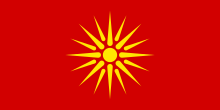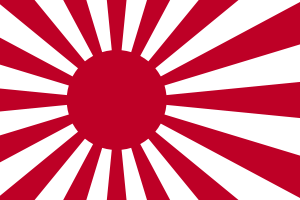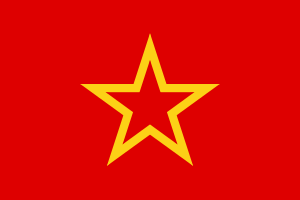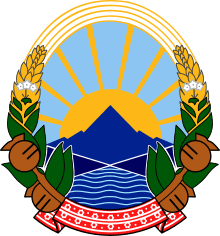Flag of the Republic of Macedonia
 | |
| Use |
National flag and ensign |
|---|---|
| Proportion | 1:2 |
| Adopted | 5 October 1995 (as established in the Constitution of Macedonia) |
| Design | A stylised yellow sun on a red field, with eight broadening rays extending from the centre to the edge of the field. |
| Designed by | Miroslav Grčev |
The national flag of the Republic of Macedonia (Macedonian: Знаме на Република Македонија) depicts a stylised yellow sun on a red field, with eight broadening rays extending from the centre to the edge of the field. It was created by Prof. Miroslav Grčev and was adopted on 5 October 1995 after a one-year economic blockade imposed by Greece in order to force the Republic of Macedonia to remove the Vergina Sun, a symbol from the gravesite of the ancient Kings of Macedon from the flag, as Greece considered it a Greek symbol. The new eight-rayed sun represents "the new sun of Liberty" referred to in the national anthem of the Republic of Macedonia, Denes nad Makedonija ("Today over Macedonia"):
- Today over Macedonia, is being born
- the new sun of liberty.
- The Macedonians fight,
- for their own rights!
The change of the flag was at first not accepted by conservative Macedonians and self-proclaimed patriots. In the first years after the change, both flags were officially flown for a long time. Between 1995 and 1998, in the municipalities where then-opposition party VMRO-DPMNE ruled, only the old flag was flown from institution buildings. Popular opinion was divided about the merits of changing the flag; a survey carried out before the Assembly's vote found that a bare majority of the population, 56.33 percent, supported the adoption of a new flag. Nonetheless the Assembly voted for the new flag by an overwhelming majority, with 110 of the 115 delegates voting in favour, one voting against and four abstaining.
Design
The flag ratio is 1:2 (height/width), with two colors:
| System | Red | Yellow |
|---|---|---|
| RGB | 210-0-0 | 255-230-0 |
| Hexadecimal format | #D20000 | #FFE600 |
.png)
History
Flag of Democratic Federal Macedonia / People's Republic of Macedonia (1944–1946)

The modern Macedonian state was proclaimed on 2 August 1944 by the Anti-Fascist Assembly of the National Liberation of Macedonia (ASNOM), the state's supreme legislative and executive body until 1946. The state was originally known as Democratic Federal Macedonia[1][2] and was renamed the People's Republic of Macedonia in 1945. The flag was adopted along with the state's laws and principles during ASNOM's first plenary session in the St. Prohor Pčinjski Monastery in modern Serbia, near the Macedonian town of Kumanovo. The first version of the flag depicted a gold-edged five-pointed red star centred on a red field.
Flag of the People's Republic / Socialist Republic of Macedonia (1946–1992)

Between December 1946 and September 1991, the Socialist Republic of Macedonia (known as the People's Republic of Macedonia until 1963) was one of the six constituent republics of the Socialist Federal Republic of Yugoslavia. It was the only Yugoslav republic not to use the Pan-Slavic colours on its flag. Macedonia instead adopted an amended version of its previous flag, depicting a gold-edged five-pointed red star in the canton against a red field in a design similar to the flags of the Soviet Union or the People's Republic of China. This flag was adopted on 31 December 1946 under Article 4 of the Constitution of the People's Republic of Macedonia[3] and remained in use until well after Macedonia's independence from Yugoslavia in September 1991, due to lack of agreement about what should replace it.
"Vergina Flag" (1992–1995)

In 1991, Todor Petrov, president of the ultra-nationalist organization World Macedonian Congress, designated and proposed the Vergina Sun as the national symbol of the Republic of Macedonia. On 11 August 1992, the newly independent Republic of Macedonia adopted the new flag to replace the old Communist "red star" insignia. The flag depicted the "Vergina Sun" symbol, a stylised yellow sun centred on a red field with eight main and eight secondary rays emanating from the sun, tapering to a point. This ancient symbol was named after the Greek town where it had been discovered in archaeological excavations of the ancient Macedonian city of Aigai.

The Vergina Sun was regarded by Greece as a symbol of continuity between ancient Macedonia and modern Greek culture, and in particular as a symbol of the Argead dynasty of Philip II of Macedon and his son Alexander the Great. From the late 1970s it had also been adopted by many both in Greece and the then Socialist Republic of Macedonia to symbolise historical connections with ancient Macedonia and had been paraded in demonstrations by Greeks and ethnic Macedonians at home and abroad.[4]
The flag, the new state's constitution and its name all became the focus of a dispute between the two countries, during which Greece imposed an economic blockade on the Republic from February 1994. In July 1995, Greece lodged a request with the World Intellectual Property Organization (WIPO) for exclusive trademark protection to the Vergina Sun. [5]
Greek objections also prevented the flag from being flown at the United Nations Headquarters building in New York City. The blockade was lifted in October 1995 when an agreement was reached to change the flag, modify the constitution and resolve the naming dispute through United Nations-sponsored negotiations.[6]
Flag proposals
Before the current state flag was officially adopted, the following flags were proposed:
Similar flags

 War flag of the Imperial Japanese Army (1870–1945)
War flag of the Imperial Japanese Army (1870–1945) Flag of the Soviet Red Army
Flag of the Soviet Red Army.svg.png) Flag of North Vietnam (1945-1955)
Flag of North Vietnam (1945-1955) Flag of North Vietnam (1955-1976) and Flag of Vietnam (1976-present)
Flag of North Vietnam (1955-1976) and Flag of Vietnam (1976-present)
See also
- Flags of the Republic of Macedonia
- Coat of arms of the Republic of Macedonia
- Flag of Macedonia (Greece)
- Miroslav Grčev
Footnotes
- ↑ "Глобус". globusmagazin.com.mk.
- ↑ "My Info Agent". mia.com.mk.
- ↑ Barraclough, E.M.C. and Crampton, William G. (eds). Flags of the World, p. 148. F. Warne, 1978
- ↑ Hamilakis, Yiannis (2009). The Nation and its Ruins: Antiquity, Archaeology, and National Imagination in Greece. Oxford University Press. p. 131. ISBN 0199572909.
From the late 1970s onwards, and as the dispute over Macedonia intensified, this motif became extremely popular, almost to the point of becoming an unofficial national crest and symbol, in both Greece and the Yugoslav Republic. Countless commercial adverts, logos, shopfronts, T-shirts, pins, medals, and posters, were carrying it, along with its official endorsement in a 100-drachma Greek coin with the head of Alexander on one face and the ‘sun’ on the other, on postage stamps, and on official campaign posters distributed throughout Greece and abroad.
- ↑ "Greece petitions for int'l rights to Vergina Star", ANA, 31 July 1995 . See also WIPO registrations: 1, 2, 3. Archived November 10, 2007, at the Wayback Machine.
- ↑ Wood, Michael C., Participation of Former Yugoslav States in the United Nations and Multilateral Treaties, "Max Planck Yearbook of United Nations Law", Vol. 1, 1997, p. 240.
- 1 2 3 4 5 6 7 8 9 10 Македонски Хералд број 5
External links
| Wikimedia Commons has media related to Flags of Macedonia. |












